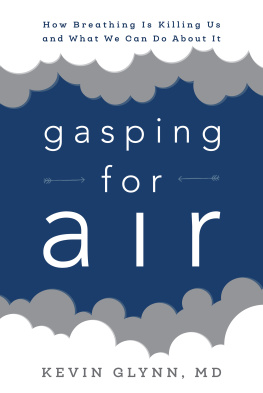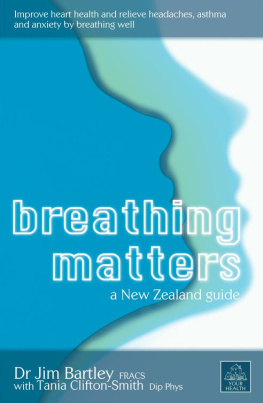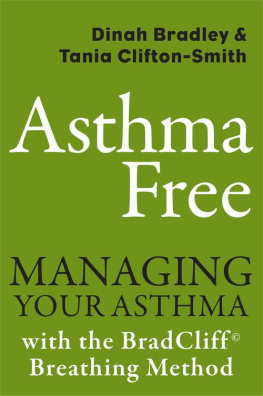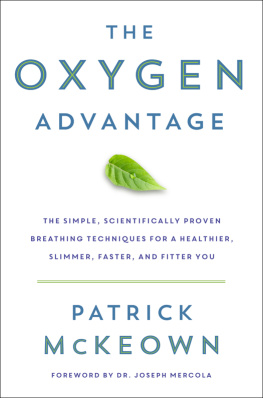Gasping for Air
Gasping for Air
How Breathing Is Killing Us and What We Can Do about It
Kevin Glynn, MD
ROWMAN & LITTLEFIELD
Lanham Boulder New York London
Published by Rowman & Littlefield
A wholly owned subsidiary of The Rowman & Littlefield Publishing Group, Inc.
4501 Forbes Boulevard, Suite 200, Lanham, Maryland 20706
www.rowman.com
Unit A, Whitacre Mews, 26-34 Stannary Street, London SE11 4AB, United Kingdom
Copyright 2017 by Rowman and Littlefield
All rights reserved . No part of this book may be reproduced in any form or by any electronic or mechanical means, including information storage and retrieval systems, without written permission from the publisher, except by a reviewer who may quote passages in a review.
British Library Cataloguing in Publication Information Available
Library of Congress Cataloging-in-Publication Data
Names: Glynn, Kevin, 1936 author.
Title: Gasping for air : how breathing is killing us and what we can do about it / Kevin Glynn, M.D.
Description: Lanham : Rowman & Littlefield, [2017] | Includes bibliographical references and index.
Identifiers: LCCN 2016057285 (print) | LCCN 2017013096 (ebook) | ISBN 9781442246249 (electronic) | ISBN 9781442246232 (cloth : alk. paper)
Subjects: LCSH: Respiratory organsDiseases. | Respiratory organsDiseasesTreatment.
Classification: LCC RC736 (ebook) | LCC RC736 .G59 2017 (print) | DDC 616.2dc23
LC record available at https://lccn.loc.gov/2016057285
 The paper used in this publication meets the minimum requirements of American National Standard for Information SciencesPermanence of Paper for Printed Library Materials, ANSI/NISO Z39.48-1992.
The paper used in this publication meets the minimum requirements of American National Standard for Information SciencesPermanence of Paper for Printed Library Materials, ANSI/NISO Z39.48-1992.
Printed in the United States of America
To Patty:
You take my breath away
The Lord God formed the man from the dust of the ground and breathed into his nostrils the breath of life, and the man became a living being.
Genesis 2:4
Contents
Timeline
How Breathing Kills | Year | What We Can Do about It |
1543 | Andreas Vesalius publishes On the Fabric of the Human Body |
1628 | William Harvey demonstrates circulation of blood |
John Bunyan labels consumption (tuberculosis) captain of the men of death | 1680 |
1700 | Bernardino Ramazzini publishes treatise on occupational diseases |
1774 | Joseph Priestley discovers oxygen |
1796 | Edward Jenner performs first cowpox vaccination (against smallpox) |
1797 | Giovanni Venturi demonstrates jet effect of forcing liquid through a small orifice |
1819 | Ren Laennec describes the pathology of emphysema |
Charles Dickens pens Pickwick Papers , in which he describes respiratory failure in obesity | 1836 |
1856 | Rudolph Virchow connects venous blood clots and pulmonary emboli |
Henry Salter describes clinical features of asthma | 1860 |
1874 | Germany passes compulsory vaccination law |
James Bonsack invents cigarette rolling machine | 1880 | Workable infant incubator invented Louis Pasteur and George Sternberg discover pneumococcus |
1882 | Robert Koch discovers tuberculosis bacillus |
1885 | Edward Trudeau opens tuberculosis sanatorium at Saranac Lake, NY |
First description of coccidioidal fungus infection | 1892 |
First polio outbreak in the United States | 1894 |
William Osler notes pneumonia has replaced tuberculosis as captain of the men of death | 1901 |
Pierre and Marie Curie isolate radium | 1902 |
Iroquois Theater fire in Chicago kills 600 people | 1903 |
1904 | Founding of National Association for Prevention and Treatment of Tuberculosis |
1907 | Christmas Seals launched |
1908 | US Congress passes first federal workers compensation law |
First case of sickle-cell disease in the United States described | 1910 |
Great Influenza kills 35 million | 1918 |
1921 | BCG vaccine against tuberculosis first administered |
1926 | Alvan Barach invents first workable oxygen tent |
1929 | Philip Drinker invents iron lung |
J. M. Campbell describes farmers lung | 1932 |
1933 | Evarts Graham performs first successful pneumonectomy for lung cancer |
Hawks Nest silicosis disaster kills 400 workers | 1936 |
Dorothy Andersen describes clinical picture of cystic fibrosis | 1938 | Jonas Salk and Thomas Francis develop first influenza vaccine |
1939 | Karl Link and Harold Campbell isolate anticoagulant dicumarol |
1942 | First civilian use of penicillin |
Los Angeles gas attack begins war on smog | 1943 |
1944 | Selman Waksman and Albert Schatz discover streptomycin active against tuberculosis |
Donora, PA, air pollution catastrophe | 1948 | Bennett valve used to assist ventilation in polio patients |
Ernst Wynder and Evarts Graham report tobacco a possible factor in lung cancer | 1949 | Public Health Service Act establishes NIH as research arm of federal government |
1950 | Edward Kendall and Philip Hench win Nobel Prize for discovering adrenal steroids |
Killer fog hits London Global polio epidemic | 1952 | Isoniazid revolutionizes treatment of tuberculosis Henrik Ibsen in Denmark uses positive-pressure ventilation to treat polio victims |
Golfer Ben Hogan sustains massive pulmonary emboli after auto accident Hyaline membrane disease described as cause of respiratory distress of newborns | 1953 | Virginia Apgar describes scoring system to predict survival of newborns |
1955 | Salk vaccine against polio released |
1959 | Mary Ellen Avery and Jere Mead connect respiratory distress of newborns with lack of surfactant Amphotericin B antifungal introduced |
1965 | Linde liquid oxygen reservoir introduced Henri Gastaut notices a connection between breathing and airway obstruction |
1966 | Kimishige Ishizaka and Gunnar Johansson describe immunoglobulin E role in allergies |
1967 | Fluconazole, first oral antifungal agent, released |
1968 | PuritanBennett introduces MA-1 ventilator |
1969 | Thomas Petty shows oxygen keeps COPD patients out of hospital |
1973 | American Lung Association adopts current name |








 The paper used in this publication meets the minimum requirements of American National Standard for Information SciencesPermanence of Paper for Printed Library Materials, ANSI/NISO Z39.48-1992.
The paper used in this publication meets the minimum requirements of American National Standard for Information SciencesPermanence of Paper for Printed Library Materials, ANSI/NISO Z39.48-1992.